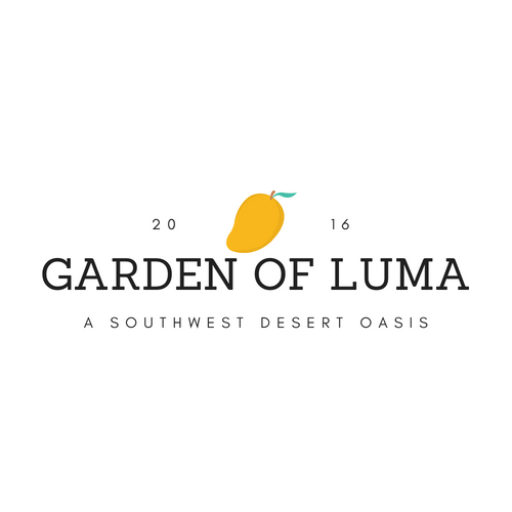Essentials for a Successful Butterfly Garden in Hot Climates
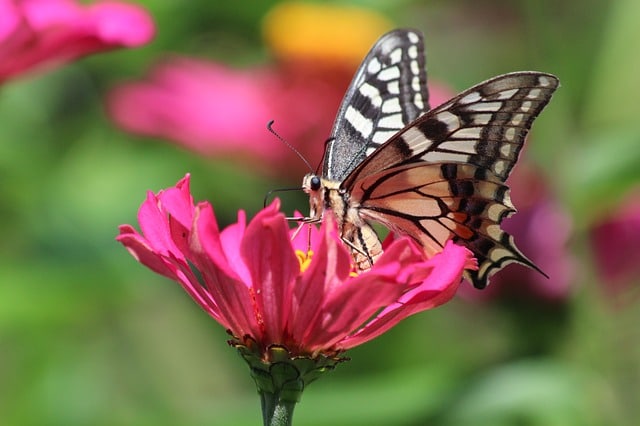
Butterflies have long been regarded as a sign of beauty. We have been enamored by the small creatures with fluttering wings of color that grace the skies around us. Something about the life cycle of these insects invokes feelings in us that we are constantly evolving and changing.
Butterflies play an integral part in our backyard gardens whether it’s as a pollinator or to witness the beauty of life. In the Arizona desert where I reside, we are fortunate to have many species.
Life-Cycle of a Butterfly
As kids, most of us read stories about the transformation of a caterpillar into a majestic butterfly or witnessed this event take place over several days in a mason jar. Let’s get reacquainted with the various stages of growth for a butterfly to help us understand what is needed in our garden for the butterfly gamut.

Stage 1
Small round eggs, which can vary slightly in shape depending on the butterfly variety, are often found on the undersides of leaves. Generally, it takes up to a week for butterfly eggs to hatch.
Stage 2
After the eggs hatch, it’s called Larva. Larva or Caterpillars are worm-like with lots of tiny legs to help them scoot along the plant. Caterpillars spend all of their time feeding off of the host plant. Butterflies lay their eggs on a plant that is the type of plant that the larva will eat. Depending on the variety, a caterpillar can remain in this stage for a week or even a year.
Stage 3
This is what’s commonly known as the chrysalis or pupa phase. The caterpillar hangs upside down from a twig or branch while spinning a cocoon made from silk forming a shell. It takes around two weeks to form the chrysalis and the larva begins metamorphosis while in the cocoon.
Stage 4
After a couple of weeks, the adult butterfly will emerge from the chrysalis. In a couple of hours, the butterfly will be ready to take flight and begin pollinating your garden through feeding on sweet nectar. The butterfly is short lived and will look to reproduce to start the cycle again.
Common Types of Butterflies found in the Desert
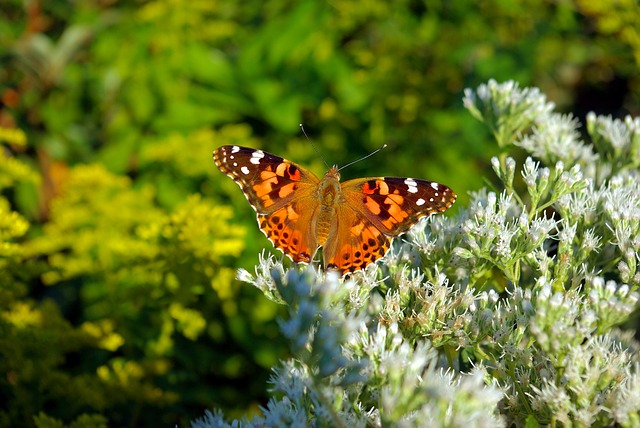
You wouldn’t think the sweltering desert would be home to many butterflies, much less anything else, but the Arizona Sonoran desert is host to a variety of species.
Since our desert tends to come alive with native flowers at various times of the year, it provides a great habit for some types of butterflies. Here are some of the more common varieties found in the desert southwest.
- Giant Swallowtail
- Painted Lady
- Pearl Crescent
- Cloudless Sulphur
- Skipper’s
- West Coast Lady
- Monarch
- Dotted Hairstreak
- Pipevine Swallowtail
- Queen
- Zebra
- Variegated Fritillary
- Buckeye
- Checkerspot
- Black Swallowtail
Starting a Butterfly Garden
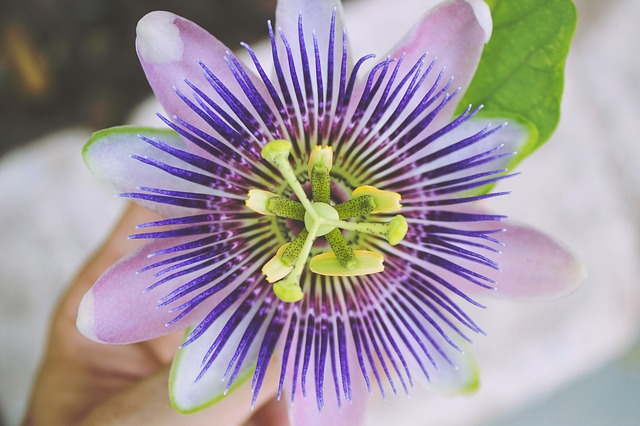
A butterfly garden doesn’t have to be a space separate from your traditional garden or within your backyard. It’s more about incorporating various plants that will support, attract, and feed butterflies within your space. Although it does help to create some density when planting versus just a single flower here and there.
One of the nice things about creating an environment that’s butterfly friendly is it often promotes planting more flowering plants and shrubs which boosts the natural beauty of your garden.
It’s important to consider the various stages of the butterfly that has been previously discussed. Flowers can attract butterflies but isn’t necessarily going to feed the earlier stages of the insect.
Larval Plants
The host plant for which the larva will reside is a larval plant. These are the plants that caterpillars will feed on throughout their lifespan. It’s important to add these types of plants to provide food for the pre-butterfly stage to invite butterflies to lay eggs and support the full life cycle.
Another thing to consider is that the caterpillars will be eating the leaves of these plants, so know that it will cause some damage to occur. Caterpillars are often killed, due to feeding on plants that are wanted. Here is a list of some things to consider planting in the desert or hot climates to promote larva:
- Aster
- Citrus
- Clover
- Grasses
- Lupine
- Marigold
- Mallow
- Milkweeds
- Passion flower
- Snapdragon
- Parsley, Dill, Fennel
- Thistle
- Violets
Nectar Plants
Many flowering plants produce sweet nectar from their glands which attracts flying insects who then become pollinators for the plant. I’ve created an in-depth guide: How to Attract Pollinators to the Garden (Even in the Desert.)
When creating your butterfly garden it’s a good idea to plant several of these types of plants, many of which are low water use plants native to the southwest. These plants produce radiant blossoms that butterflies love.
- Ageratum
- Aster
- Anise hyssop
- Cosmos
- Bee Balm
- Cornflower
- Black-eyed Susan
- Heliotrope
- Blanket flower
- Lantana
- Bush Cinquefoil
- Lobelia
- Butterfly Bush
- Marigold
- Butterfly weed
- Mignonette
- Catmint
- Nasturtium
- Chives
- Pincushion flower
- Coreopsis
- Sunflower
- Daisy
- Sweet Alyssum
- “Torch” Tithonia
- Ornamental onion
- Verbena
- Purple coneflower
- Zinnia
- Rosemary
- Salvias
- Yarrow
Why Butterflies are Important for the Garden

Seeing things like butterflies are an indicator for us gardeners that we have a thriving ecosystem. Everything is part of the circle of life or food chain needed for sustainability.
For example, if you’re seeing butterflies, it’s a good indication that you also have whatever is feeding on butterflies and whatever butterflies are feeding on nearby. It can help create balance, so your garden isn’t overrun by bad bugs or by bringing in beneficial bugs. So, why else do we care about butterflies?
The Arts
There have been numerous photos, poems, stories, and songs involving a butterfly. Much of gardening is an art form, not only does it provide food, but something for us to enjoy through our senses. Butterflies become another element for beautifying our space.
Make us Aware
Butterflies help educate us about our natural world. Butterfly migration, flying habits, wing structures, and life cycles have all fascinations with the study of these insects.
Butterflies provide us gardeners with a sense of awareness for life and an ever constant reminder of our need for conservation of nature. Butterfly tours and habitats have been popular with enthusiasts all over the world.
Maintain Nature
Butterflies are one of those key pollinators necessary for fruit/vegetable production and plant reproduction. In places or times of the year when bees are sparse, butterflies can aid in supplementing some of the pollination needs.
There are certain types of flowers that only butterflies can pollinate and they tend to be more attracted to specific colors that other pollinators may overlook.
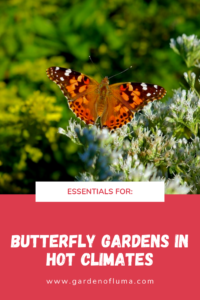
Final Thoughts
Creating a butterfly garden can be as simple or elaborate as you want it to be. By just adding a few nectar and larval types of plants, it’ll attract butterflies for your enjoyment and to help improve your garden ecosystem. Seeing these beauties are a constant reminder of the amazing life around us.
Please comment below on anything that you’ve enjoyed from this post or experiences with butterfly gardens.
